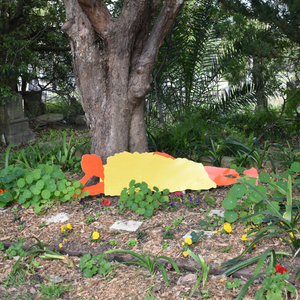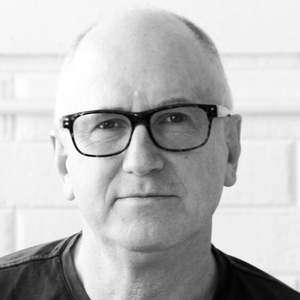Reading for the Living and for the Dead (2022)
Reflective film on aluminium, wooden furniture, growing and dying flowers and live readings

Reading for the Living and for the Dead follows Early Buddhist traditions where talks and recitations were conducted out of doors, particularly in groves. I’ve created this site for the reading as a sanctuary for people to pause, sit and listen. In this case the recitation will be from the ‘Last Days of the Buddha’ Sutta. The text was traditionally memorised then recited or chanted to groups of listeners. In recent centuries it has been translated into English and studied in its written form. On selected days of the HIDDEN exhibition, I will read the Sutta text aloud in English for two hours, within the grove of my installation. The chosen text focuses on the Buddha’s passing with themes of life, death and transience.
About the Artist

Lachlan Warner was born on Wiradjuri Country in western NSW and now lives on Wangal Country, in the Inner West of Sydney. He completed his MFA at Rutgers, then later completing his PhD at Sydney College of the Arts. Lachlan won the Blake Prize 2001, the Campbelltown Contemporary Art Prize 2005, and the Burwood Art Prize 2019. He has exhibited in Australia, Thailand, the United States, Japan and the Netherlands. Lachlan describes himself as a stumbling Buddhist. He is a member of the Association of Engaged Buddhists. Over the last decade Lachlan has explored imagery of Siddhartha Gautama (the Buddha) when describing the human condition of Dukkha (suffering).
Live readings: Join the artist, Lachlan Warner, every Wednesday 4-6pm and Sunday 10am-12pm during the HIDDEN exhibition, and listen to him Reading for the Living and for the Dead.
Listen to Lachlan's Reading
Transcription
My name is Lachlan Warner and I'm an artist based in the inner west of Sydney.
My artworks are mostly inspired by Buddhist teachings, particularly around ideas of life and death. In terms of media, I work across different media depending on the project that comes to the four and whatever that project dictates, then that's what I use.
For Rookwood I'm making a small garden and in that garden will be a reclining Buddha figure. The image of the Buddha in this reclining pose is both a meditation pose but it's also, mythologically, the pose that the Buddha died in. He lived about eighty years, we think, and he died a fairly long, slow, painful death, seemingly from food poisoning. So it's not that we're in a sense shying away from death, but being a part of it, understanding that to really fully live we have to be engaged with the reality of our death. How do we live more fully because of that?
So in this garden will be the reclining Buddha figure and twice a week during the HIDDEN festival, I am going to be reading in that garden from the early Buddhist text and particularly I'm going to be reading around ideas of life and death, the key themes of Buddhism. As I said, my artistic practice is very much based around Buddhist ideas and the materials are very much dictated by the kinds of projects that I take on. In the past a lot of those materials have been quite ephemeral, impermanent. So I've used things like raw clay and compost and history wrapping foil to make images that resonate with ideas of life and death.
For me, Rookwood is a very interesting place to work. Obviously it is about death and dying and memorializing those who have died. It's visually rich, it's a garden setting in and of itself and it's a place where one can pause and, I think, quite comfortably think on death, death of our family, our friends and even our own death, and contemplate that in this context. I think is to contemplate this in this context. It's a very rich and powerful thing. I hope it's an introduction to Buddhist ideas of death and dying. I hope that it's an uplifting experience where one can take those ideas on in dare I say it, a positive way, in a way that is rich in to this life so that we live more full in this life. I hope that it's simply beautiful and absorbing and in a sense different, because Rookwood in itself doesn't have a lot of imageries from the Buddhist tradition.
There is called a Chinese section that has some Buddhist images in its the pavilion, but it's a different kind of conception of death to most western traditions.